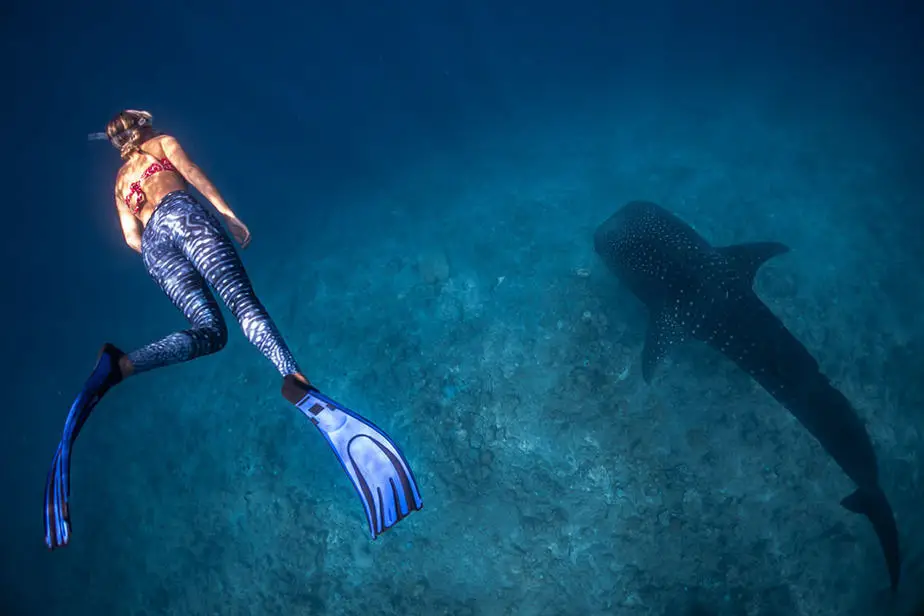Sports such as swimming, snorkeling, and scuba diving all benefit from using fins. However, when you look at the average freediving fin, you’ll notice that they are significantly longer than fins designed for other water activities.
If you’ve ever had the opportunity to wear long freediving fins, then you will get to experience how initially awkward and difficult a task it is to move in them. Why are freediving fins so long? Doesn’t it just make it very cumbersome to use them?
The reason why freediving fins are so long is because it helps to displace more water per kick. In other words, you spend less energy per kick, increasing your efficiency and allowing yourself to propel through the water rapidly. While freediving, you need to conserve as much energy and oxygen as you can. Fins with long blades make it faster and easier to cover long distances while conserving oxygen, making them invaluable for freediving.
Travelling with Freediving Fins
The blade length on freediving fins run anywhere from 31.5 in. (80cm) to 38.5 in. long. This measurement excludes the foot pocket, which will add another few inches. As you can imagine, this makes travelling with freediving fins quite a hassle. Many long fins are simply too long to fit in regular bags and suitcases. You have two choices:
Purchase adjustable freediving fins. Adjustable fins are more expensive, however they give you the option to remove the blade which decreases the overall length. The fin blades are still long by themselves, but this makes packing slightly easier.
Purchase a dedicated fin bag. You can also invest in a fin bag that is specifically designed for storing freediving fins. Dedicated freediving fin bags should exceed 40 in. in length to accommodate even the longest freediving fins. The interior should be heavily padded to cushion your expensive fins and ensure they will survive the hardships of travel unscathed.
If you will be taking your freediving fins on an airplane, you definitely need to invest in a fin bag. Airport security will be rough with your luggage and they will almost certainly get damaged unless you have a sturdy bag.
Note: don’t try to sneak your fin bag onto the plane and use the “but it’s a carry-on” excuse. Carry-on luggage has maximum dimensions that vary across airlines, however a 40 inch or longer fin bag certainly exceeds those limits and can result in them getting confiscated.
Some airline staff may not care about your fin bag as long as it still fits in the overhead bin. Others may ask you questions because they are genuinely curious about your extremely long fins. However, you bring them on board at your own risk.
The safest option is to get the sturdiest bag you can find and get them checked-in. We recommend this fin bag for travelling. It’s large enough to store nearly any freediving fin. Furthermore, its numerous pockets can store additional items such as passports, masks, clothes, towels, and the like to make travelling very convenient.
Long Fins vs. Short Freediving Fins
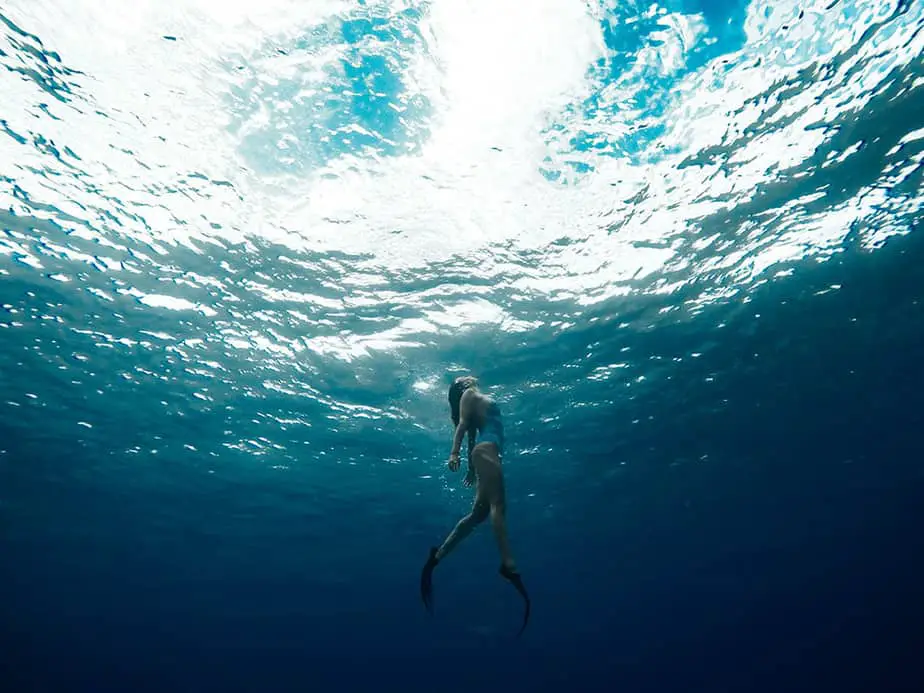
Long freediving fins generate more thrust per kick, however it requires strong leg muscles to maximize its potential. Short freediving fins are easier to kick with, but generates less thrust and requires more kicks to achieve the same results.
So how does having powerful kicks that are harder to perform compare to having less powerful but more frequent kicks that are easier to perform? Is the net energy expenditure and distance travelled comparable?
It’s hard to say, as this isn’t an apples to apples comparison. Long fins are the preferred choice over short fins because they have more “potential” power with each kick. Imagine riding a bicycle on the highest gear compared to the lowest.
On high gear, it’s harder to pedal but you can go way faster. On low gear, you can pedal quickly but you can also end up just spinning your wheels without moving any faster. It’s the same idea when it comes to long blades vs short blades.
With long blades and strong legs to take advantage of them, you can get immense thrust with each kick. On the other hand, if you have strong leg muscles and try to kick with short blades, you can “cap out” or reach a limit where no matter how hard or fast you kick, you don’t move any faster. You are effectively “spinning your wheels” and wasting valuable oxygen and energy.
Every bit of oxygen is vital when freediving. Sometimes the difference between successfully resurfacing and blacking out is just a few seconds apart. Wasted energy can cause you to lose your life to freediving. Do you want to bet your life on a slower, shorter fin when you’re almost out of breath and gasping for air?
In order to achieve greater results and push past your limits, you need to be wearing long freediving fins. They will help you rapidly dash to the bottom and back up again by providing the thrust you need to freedive.
Short Freediving Fins Overview
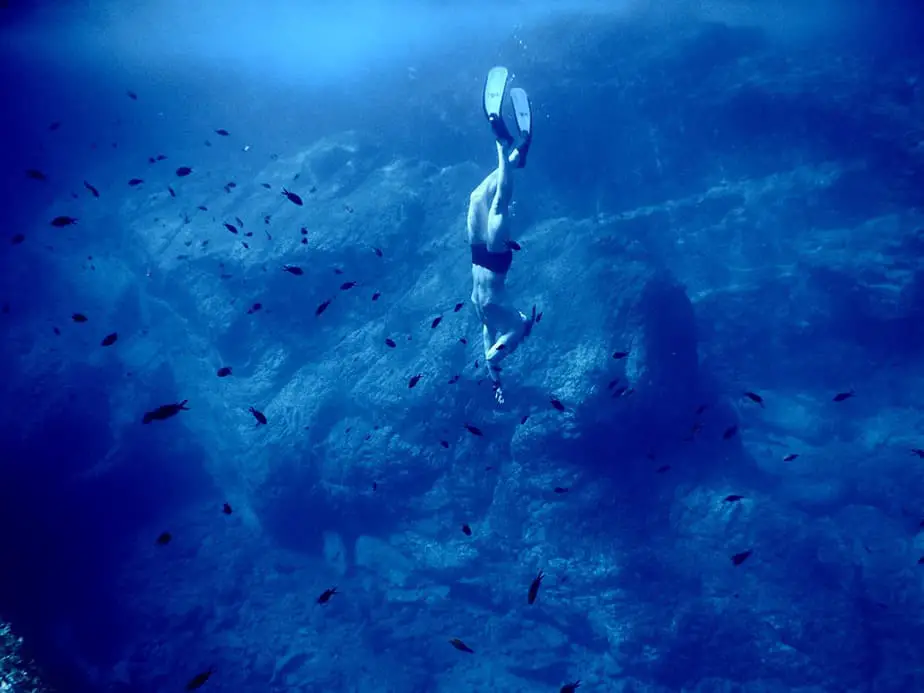
Even though we are primarily focusing on fin blade length and the advantages and disadvantages long and short ones have, obviously other factors contribute to the overall quality of a pair of freediving fins. For instance, fin material, flexibility, durability, type of foot enclosure, ridge styles, price, etc, all matter, all of which we cover in our review of the best freediving fins for beginners.
Thrust
It’s hard to get any thrust when diving without fins. Even short fins can provide significantly more thrust compared to barefoot diving. However, the difference between diving without fins versus with short fins is kind of like the difference between diving with short fins versus long freediving fins; you are not maximizing your kicking power and thrust.
With short fins, it’ll feel like each kick is choppy and short no matter what kicking technique you perform. Furthermore, the rapid kicking burns up your energy and oxygen reserves faster. Short fins also struggle to perform in strong currents.
Depth
The deeper you dive, the more negatively buoyant you become (instead of floating up, you get pulled downwards). This phenomenon occurs around the 10 meter mark (35 feet deep) and is great when you’re heading down. However, this may become an issue on the way back when you’re nearly out of breath and it feels like the ocean is dragging you down.
Thus, the deeper you dive, the more thrust you need to overcome the negative buoyancy in order to safely resurface, and short fins may let you down.
Maneuverability
Thanks to their short blade length, it is easier to perform turns and change directions underwater. Performing the same movements with long freediving fins can be cumbersome even for experienced divers. Furthermore, with short blades you are less likely to hit something or feel drag as you turn in the water. This makes it easy to reposition and chase after agile fish.
Comfort
Short blades will provide a more comfortable experience both in the water and outside of it. You don’t have to deal with the extra bulk, weight, and drag that longer blades have. Turning, finning, walking; just about every action you do will feel easier to perform.
That’s not all. Many short freediving fins feature open heel foot pockets. This lets you wear insulating dive booties with padded soles. If you are diving in cooler waters, this setup will help you stay cozy and comfortable. With that said, you are sacrificing lots of performance in order to experience these comforts, so any competitive freediver should still choose long freediving fins.
Usability
There’s not much difference between short freediving fins and the fins used for swimming, snorkeling or SCUBA diving. Even the kicking techniques are relatively the same and intuitive, so if you have any experience in the aforementioned sports, then you will feel right at home wearing short freediving fins. Also, you don’t need as much leg strength to perform a kick, so it’s a good stepping stone towards building stronger leg muscles.
Energy Consumption
Although short fins require less energy to perform a kick, if we are comparing it to traveling large distances quickly, you will need to perform numerous kicks in quick succession which will burn through your energy reserves quickly. Remember the bike analogy; swimming with short fins is like being stuck in first gear.
Cave/Wreck Exploration
When exploring tight spaces such as caves, wrecks, or coral-dense locations, having a pair of short fins is ideal. You won’t have to worry as much about damaging or scraping your fins, and repositioning yourself in tight space is easier.
Travel and Storage
Shorter fins are much easier to travel with and store because they can actually fit in most bags and suitcases. No need to buy a dedicated fin bag or shop for expensive modular freediving fins.
Long Freediving Fins Overview
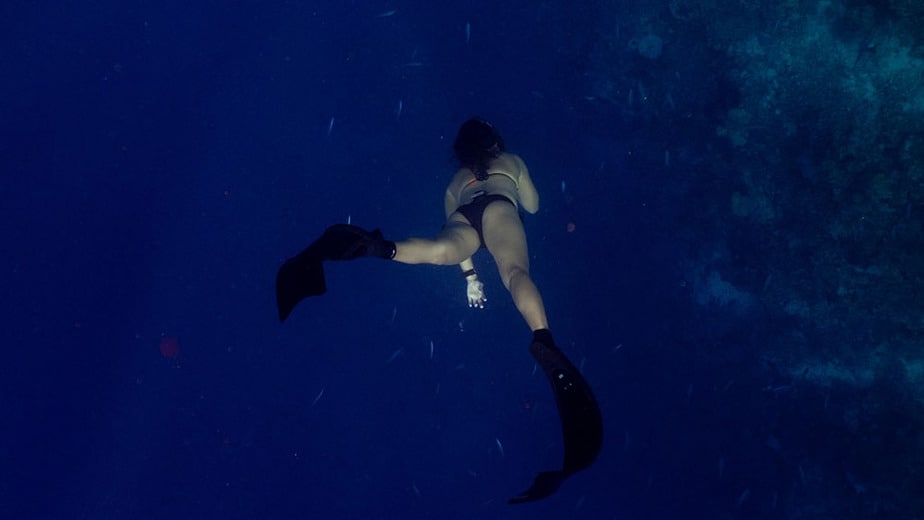
Thrust
The longer fin blades help you displace more water with each kick, generating more thrust to propel you through the water. With long freediving fins, you will focus on slower, larger kicking motions that start from the hips and utilizes your entire legs.
Depth
On your ascent, you will have to fight against the negative buoyancy slowing you down. With the help of long fin blades, you will more efficiently slice through the water and rapidly resurface, making them excellent for deep dives.
Maneuverability
Compared to short fins, it is cumbersome to perform precise, small movements due to the drag and resistance caused by the larger surface area of longer blades. This means turning and repositioning is more difficult, requiring a high level of skill and finesse for such simple actions.
Comfort
Most long freediving fins are designed with full foot pockets which provide a tighter fit, however they may feel cramped, clammy, and uncomfortable during a long freediving session. To avoid this, consider purchasing fins one size higher and wear diving boots to fill up the extra space and provide a snug fit once again.
Now you can enjoy padded soles while keeping your skin from getting rubbed raw against the heel. Long freediving fins are not as comfortable as other fins, but the performance they offer is undeniable, so you should do whatever you can to make it comfortable for you and eventually you will get accustomed to it.
Usability
Turning and performing precise movements is more difficult with long blades. There will definitely be an adjustment period as you get used to the new kicking technique. Furthermore, without strong leg muscles you will struggle to perform even basic kicks. With that said, it provides a great leg workout and eventually your muscles will develop enough so that you can handle long freediving fins easily and efficiently.
Energy Consumption
Though it is harder to perform a kick with a long fin, each kick will be very efficient in terms of distance, speed, and thrust. You will actually end up saving oxygen and energy with more effective and efficient kicks compared to diving with short fins. However, even the performance of long freediving fins doesn’t compare to the monofin.
Cave/Wreck Exploration
The long fin blades require space to use efficiently and should not be used for cave and wreck diving. They are expensive and sensitive, and you do not want to damage your fins by accidentally kicking something sharp. Furthermore, lack of mobility can make the situation dangerous, particularly if you are using stiff carbon fiber fins.
Storage and Travel
Long freediving fins are too large for most fin bags and suitcases which makes them hard to travel with or store. Ideally, you would invest in a dedicated freediving bag for long fins, or buy fins with removable blades.
This way, you can save some space though you will probably still require a medium sized bag to fit everything. Furthermore, long freediving fins are probably too large to bring aboard an airplane as carry-on since they have very strict size requirements.
Why Are Freediving Fins so Long Recap
Now that we’ve got the pros and cons of short and long freediving fins out of the way, it should be clear why the many advantages provided by long fin blades makes them the ideal choice for competitive freedivers.
With that said, you can still freedive with short fins! You just have to understand the trade-offs, particularly in regards to underwater time and depth. The benefits are that short fins are more comfortable, convenient, and easy-to-use.
If you are just starting out or have a limited budget, there’s nothing wrong with freediving with short fins. Particularly if you haven’t developed your leg muscles enough for long freediving fins, then use short fins to build up your leg muscles in the meantime. Once you’ve got the hang of freediving and want to invest into some better fins, then look into getting long freediving fins with removable blades.
SCUBA Fins vs. Long Freediving Fins
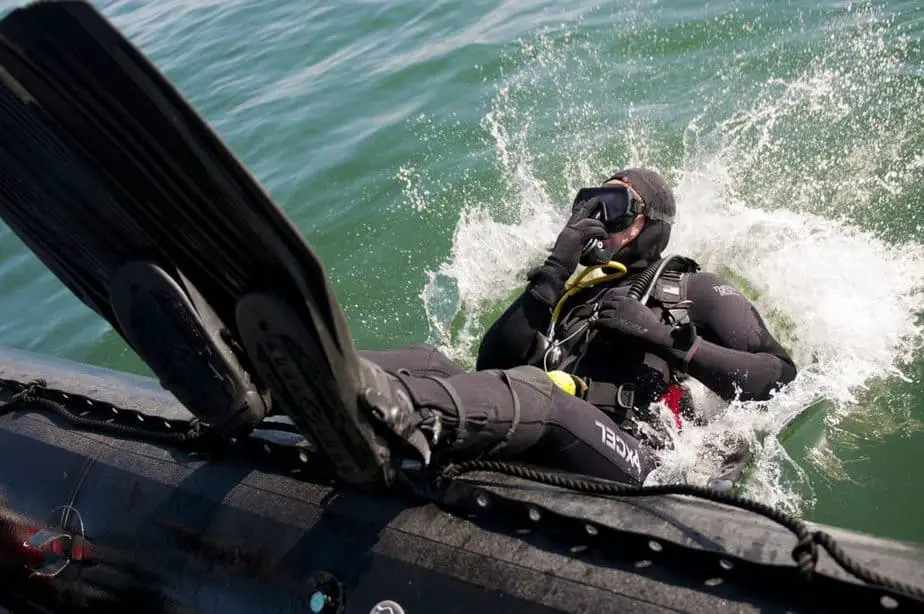
What are the differences between the fins used for SCUBA diving and freediving? After all, both fins are intended for use deep underwater, but you might be surprised to learn that SCUBA diving fins are short because SCUBA divers want fins that are easy to kick with. Here’s why.
SCUBA diving requires lots of bulky, heavy gear that already increases underwater resistance and drag. For each dive, you need to lug around an oxygen tank, a breathing apparatus, dive weights, and more. Add on a pair of long fins which, as we’ve discussed, requires significant leg strength to efficiently utilize, and you have a SCUBA diver that struggles just to move.
Too much resistance will tire you out and you won’t be able to dive for very long. That’s why SCUBA fins are designed to be easy to use and relatively short. You should be able to kick with little effort and move at a slow, but constant pace while exploring the environment.
So if you want to perform well in both of these water activities, we recommend getting two separate fins for each activity: long freediving fins for freediving, and short SCUBA fins for diving.
Now that you have a basic understanding of SCUBA fins vs. freediving fins, let’s go over the materials that these fins are made of and how they impact performance in the water. Freediving fins are often made from these three materials from cheapest to most expensive: plastic, fiberglass, and carbon fiber.
Freediving Fin Materials
Plastic Freediving Fins
When you perform a kick with a long-bladed fin, it bends. The blade will try to straighten itself back into its original shape, and this snapping action helps propel you through the water and generates thrust. All blades do this, but the effect is more noticeable with long-bladed fins.
The snapping action is referred to as a blades’ responsiveness and is why long fins offer better performance than short fins. The power that the blades can generate depends on the material it is constructed of.
For instance, the cheapest and most common fin material, plastic, has very low responsiveness. When the blades are bent, they don’t “snap” back in place so much as they slowly return back to their original shape. This makes for a mediocre thrust, and you get less power per kick compared to higher-end blades constructed from carbon-fiber or fiberglass.
Furthermore, plastic freediving fins are very stiff. In other words, when kicking with a plastic freediving fin the blade remains rigid and barely bends. This results in the large surface area of the fins adding drag when it is supposed to help you overcome it.
With that said, plastic freediving fins are still better than diving without fins. Additionally, they are very affordable and should be the starting point for beginners who are on the fence about whether they should invest in fiberglass or carbon fiber fins in the future.
If you’re not sure which plastic or elastomer freediving fins you should be using, we recommend this one.
Fiberglass Freediving Fins
After you’ve used plastic freediving fins and you feel like it’s time to upgrade to better fins, then you should consider getting fiberglass.
The difference between fiberglass and plastic is like night and day. Fiberglass fins are more responsive and flexible compared to plastic. You will immediately feel the power that these blades provide as they snap back into place.
This will result in a significant speed boost and a greater return on performance to energy expenditure compared to plastic. Fiberglass fins are the middle option; more expensive than plastic, but cheaper than carbon fiber.
Carbon Fiber Freediving Fins
Carbon fiber freediving fins are the most expensive and high-quality fins to strive for. They are typically used for deep dives because they help divers resurface quickly. This is possible thanks to its responsiveness and flexibility.
With each kick, the blade can bend more than 90 degrees, and this impressive wind up results in an explosive snap back, propelling divers through all kinds of water resistance like a torpedo.
With carbon fiber fins, you can conserve the most energy which allows you to perform the deepest dives without gassing out as quickly compared to fiberglass and plastic fins. The carbon fiber fin’s strength lies in its flexibility, but you also need to have good stiffness as well.
Also, having a pair of high-quality fins does not make up for a lack of skill. A good freediver is a good freediver regardless of their gear, and only practice and experience can contribute to that. Furthermore, beginners most likely won’t invest such a large sum of money for carbon fiber fins until they have more experience.
If you are looking for a good entry-level carbon fiber fin, then check out these ones. In addition to their great flexibility, they are lightweight and will help you jet through the water like a torpedo. You’ll be amazed at how much thrust you can generate with each kick.
Long Freediving Fins Kicking Technique
Long freediving fins have a lot of surface area which causes you to experience more water resistance when kicking. Without strong leg muscles, kicking will feel difficult and you will likely compensate for this lack of strength by bending your knees.
This is not the proper way to kick with long freediving fins. You must keep your legs relatively straight, with only a slight bend in your knees. Each kick should start from the hips and incorporate the entire leg. The knees should not bend much, your body should stay straight, and your hips need only roll slightly. Check out the video below for a demonstration.
https://www.youtube.com/watch?v=N693LINxGZc
Also, make sure you move your legs an equal distance in front of your body as you do behind your body. This can be hard to do initially, since your body is not used to this technique, however you must drill this motion into your body until you’ve got it memorized. Soon, your leg muscles will develop and kicking with long freediving fins will feel like second nature.

